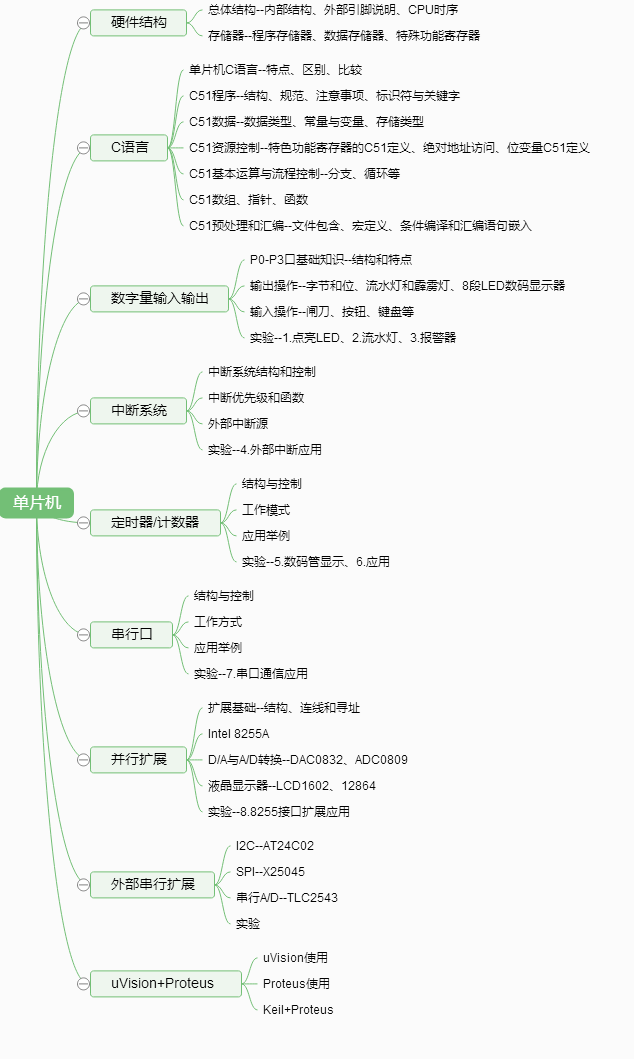如何快速学会单片机编程并应用?先上一些参考资料,主要来源知乎:1 -怎样学会单片机?-2 -arduino、arm、树莓派、单片机四者有什么不同?-3 -单片机可以替代PLC么?-4 -单片机有没有必要用汇编讲?-5 -相关课程-单片机和C语言,是自动化(机器人)学科重要的基础内容。如果对机器人感兴趣,可参考机器人工程师学习计划。课程学习动机~Why?为什么学习单片机编程?单片机方向就业?把握市场需求!软硬件能力的综合训练,电路原理图+软件编程(C语言)。
课程学习内容~What?单片机编程包括哪些内容?目录和大纲,归纳和总结能力训练
课程学习方法~How?如何学习单片机编程?在掌握基础知识后,仿真与实验。Linux平台:MCU 8051 IDEWindows平台:uVision+Proteus扩展提升:在学完51单片机后,能够快速自学更为通用主流的嵌入式系统,如下:C51--(Arduino、MSP430)--(2812、28335)--(STM32、ARM9)--(TK1、BeagleBone、Raspberry Pi)那么问题来了,我们为什么不直接学习STM32等,而是要学习51呢?入门简单、上手容易,欲知详情点击查看。 其他参考资料:单片机技术理论与实践课程相关资料,课件、资料和工具软件等。-新更新考核材料和参考报告-编程语言。单片机泥石流负能量! 在美国大学计算机专业都学什么?2016 年最受欢迎的编程语言是什么?凭兴趣求职80%会失败,为什么?
视频短片:STEM教育 1 2 3 | ROS | 智慧家居 | 智能驾驶 模块化,低耦合 参考软件工程学示例1 51+arduino
示例2 51+arduino
其他參考資料:http://blog.csdn.net/zhangrelay/article/details/52336300
课程学习内容~What?单片机编程包括哪些内容?目录和大纲,归纳和总结能力训练

课程学习方法~How?如何学习单片机编程?在掌握基础知识后,仿真与实验。Linux平台:MCU 8051 IDEWindows平台:uVision+Proteus扩展提升:在学完51单片机后,能够快速自学更为通用主流的嵌入式系统,如下:C51--(Arduino、MSP430)--(2812、28335)--(STM32、ARM9)--(TK1、BeagleBone、Raspberry Pi)那么问题来了,我们为什么不直接学习STM32等,而是要学习51呢?入门简单、上手容易,欲知详情点击查看。 其他参考资料:单片机技术理论与实践课程相关资料,课件、资料和工具软件等。-新更新考核材料和参考报告-编程语言。单片机泥石流负能量! 在美国大学计算机专业都学什么?2016 年最受欢迎的编程语言是什么?凭兴趣求职80%会失败,为什么?
视频短片:STEM教育 1 2 3 | ROS | 智慧家居 | 智能驾驶 模块化,低耦合 参考软件工程学示例1 51+arduino
#include //寄存器定义
#include //一般I/O口定义
/***以下是全局变量定义*********/
sbit LED=P1^0; //LED灯连接在P1.0上
int data i; //定义一个整型全局变量
/*********主程序开始***************/
void main(void)
{ while(1)
{ LED=0; //LED灯点亮
for(i=0;i<1000;i++); //延时
LED=1; //LED灯熄灭
for(i=0;i<1000;i++); //延时
}
}
#include //寄存器定义
#include //一般I/O口定义
/***以下是全局变量定义*********/
sbit LED=P1^0; //LED灯连接在P1.0上
int data i; //定义一个整型全局变量
LED_demo() //LED函数
{ LED=0; //LED灯点亮
for(i=0;i<1000;i++); //延时
LED=1; //LED灯熄灭
for(i=0;i<1000;i++); //延时
}
/*********主程序开始***************/
void main(void)
{ while(1)
{
LED_demo();
}
}
/*
Blink
Turns on an LED on for one second, then off for one second, repeatedly.
Most Arduinos have an on-board LED you can control. On the UNO, MEGA and ZERO
it is attached to digital pin 13, on MKR1000 on pin 6. LED_BUILTIN is set to
the correct LED pin independent of which board is used.
If you want to know what pin the on-board LED is connected to on your Arduino model, check
the Technical Specs of your board at https://www.arduino.cc/en/Main/Products
This example code is in the public domain.
modified 8 May 2014
by Scott Fitzgerald
modified 2 Sep 2016
by Arturo Guadalupi
modified 8 Sep 2016
by Colby Newman
*/
// the setup function runs once when you press reset or power the board
void setup() {
// initialize digital pin LED_BUILTIN as an output.
pinMode(LED_BUILTIN, OUTPUT);
}
// the loop function runs over and over again forever
void loop() {
digitalWrite(LED_BUILTIN, HIGH); // turn the LED on (HIGH is the voltage level)
delay(1000); // wait for a second
digitalWrite(LED_BUILTIN, LOW); // turn the LED off by making the voltage LOW
delay(1000); // wait for a second
} 示例2 51+arduino
#include //预处理命令,reg52.h是一个头文件
#include
void Function1(void); //自定义函数Function1声明
unsigned int ch;//全局变量声明
void main(void) //主函数
{
SCON=0x50; //SCON:模式1,8bit异步串口通信
TMOD=0x20; //TMOD:定时器1为模式2,8bit自动装载方式
TH1=221; //TH1:1200bit/s的装载值,16MHz
TR1=1; //TR1:timer1运行
TI=1; //TI:设置为1,以发送第一个字节
while(ch<=5)
{
Function1( );//调用自定义函数
printf("char=%d
",ch);//程序语句
}
while(1);
}
void Function1(void) //自定义函数Function1
{
unsigned char ps; //自定义函数内部变量声明
ps=1;
ch=ch+ps;
}
#include //预处理命令,reg52.h是一个头文件
#include
void Function1(void); //自定义函数Function1声明
void Init1(void);
unsigned int ch;//全局变量声明
void main(void) //主函数
{
Init1();
while(ch<=5)
{
Function1( );//调用自定义函数
printf("char=%d
",ch);//程序语句
}
while(1);
}
void Function1(void) //自定义函数Function1
{
unsigned char ps; //自定义函数内部变量声明
ps=1;
ch=ch+ps;
}
void Init1(void)
{
SCON=0x50; //SCON:模式1,8bit异步串口通信
TMOD=0x20; //TMOD:定时器1为模式2,8bit自动装载方式
TH1=221; //TH1:1200bit/s的装载值,16MHz
TR1=1; //TR1:timer1运行
TI=1; //TI:设置为1,以发送第一个字节
}
/*
Serial Call and Response in ASCII
Language: Wiring/Arduino
This program sends an ASCII A (byte of value 65) on startup
and repeats that until it gets some data in.
Then it waits for a byte in the serial port, and
sends three ASCII-encoded, comma-separated sensor values,
truncated by a linefeed and carriage return,
whenever it gets a byte in.
Thanks to Greg Shakar and Scott Fitzgerald for the improvements
The circuit:
* potentiometers attached to analog inputs 0 and 1
* pushbutton attached to digital I/O 2
Created 26 Sept. 2005
by Tom Igoe
modified 24 Apr 2012
by Tom Igoe and Scott Fitzgerald
This example code is in the public domain.
http://www.arduino.cc/en/Tutorial/SerialCallResponseASCII
*/
int firstSensor = 0; // first analog sensor
int secondSensor = 0; // second analog sensor
int thirdSensor = 0; // digital sensor
int inByte = 0; // incoming serial byte
void setup() {
// start serial port at 9600 bps and wait for port to open:
Serial.begin(9600);
while (!Serial) {
; // wait for serial port to connect. Needed for native USB port only
}
pinMode(2, INPUT); // digital sensor is on digital pin 2
establishContact(); // send a byte to establish contact until receiver responds
}
void loop() {
// if we get a valid byte, read analog ins:
if (Serial.available() > 0) {
// get incoming byte:
inByte = Serial.read();
// read first analog input:
firstSensor = analogRead(A0);
// read second analog input:
secondSensor = analogRead(A1);
// read switch, map it to 0 or 255L
thirdSensor = map(digitalRead(2), 0, 1, 0, 255);
// send sensor values:
Serial.print(firstSensor);
Serial.print(",");
Serial.print(secondSensor);
Serial.print(",");
Serial.println(thirdSensor);
}
}
void establishContact() {
while (Serial.available() <= 0) {
Serial.println("0,0,0"); // send an initial string
delay(300);
}
}
其他參考資料:http://blog.csdn.net/zhangrelay/article/details/52336300